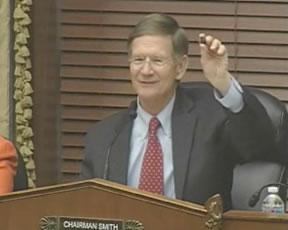Talking Asteroids in Washington, D.C.
On Monday, March 25th, I had the honor to give two briefings on the OSIRIS-REx Asteroid Sample Return Mission to policy makers in Washington DC. OSIRIS-REx will visit asteroid 1999 RQ36, a carbon‐ and water‐rich object that is also one of the most potentially hazardous near‐Earth asteroids. This visit was scheduled in conjunction with the OSIRIS-REx Independent Assessment Review (IAR) on March 26th. The IAR is the last of a mission Preliminary Design Reviews and focuses on the credibility of the management, cost, and schedule plans.
My first stop of the day was at the White House Office of Science and Technology Policy (OSTP), where I was scheduled to give a Brown Bag lunchtime seminar on OSIRIS-REx. Jim Green, Director of NASA’s Planetary Science Division, Ed Beshore, OSIRIS-REx Deputy PI, and Shay Stautz, UA Vice President for Federal Relations joined me. We had a full house and several notable attendees including John Holdren, Director of OSTP, Philip Rubin, Principal Assistant Director for Science, and Tammy Dickinson, Senior Policy Analyst and our host. LPL alum Celinda Marsh (M.S., 2007), who now works at the Office of Management and Budget, was also able to join us. The meeting started out on a high note since I was able to pass around several fragments of the Chelyabinsk chondritic meteorite, which had exploded over Russia just one month prior to this presentation. Jim Green provided a nice overview of near-Earth objects and NASA’s wide-ranging efforts to study these bodies. I followed with a detailed overview of OSIRIS-REx, highlighting the exciting science and feed-forward technologies for the agency. Afterwards, Tammy let me know that everyone at OSTP was still talking about both the mission and the sample of Chelyabinsk that I left behind. It had several visitors that afternoon.
Later that afternoon, Shay and I traveled to Capitol Hill to provide a similar briefing for staff members of the House Science, Space, and Technology Committee. UA worked with both full committee staff director Chris Shank as well as with Arizona Representative David Schweikert to arrange that discussion. Our host for this briefing was J.T. Jezierski, Director of Coalitions and Member Services for the Science, Space, and Technology Committee. Staff representing six Committee Members attended. Again, the samples of Chelyabinsk provided an excellent introduction to the scientific value of studying asteroids and meteorites. This venue provided for a more intimate setting, with Shay and I sitting around a conference table with the staff members. I presented a general overview of asteroid science and discussed the OSIRIS-REx mission. The conversation was dynamic and covered a wide range of topics from Solar System to formation to asteroid impact hazards, and resources of near-Earth space. I also left behind a sample of Chelyabinsk for J.T. to pass on the Chairman Lamar Smith. The Chairman used the asteroid fragment to highlight the Chelyabinsk airburst event and kick-off the Full Committee Hearing - Threats from Space: A Review of Private Sector Efforts to Track and Mitigate  Asteroids and Meteors, Part II (see photo).
Asteroids and Meteors, Part II (see photo).
Overall, the visits to OSTP and Capitol Hill were very successful. Asteroid research and exploration is emerging as a top priority for the United States. This avenue of research is critical to understanding Solar System origins, assessing the asteroid impact threat, and pursuing resource development in near-Earth space.

